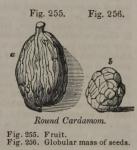Mé tlé, Cochinch.; Tsao keu, Chin. Loureiro, Fl. Cochin.—Mountains of Cochinchina and China.
I am indebted to Professor Guibourt for the loan of this fruit, which he calls the round China cardamom (cardamnme rond de la Chine), and from which the accompanying figure was taken.
Capsule thin, round, or oval. Seeds in globular masses, marked, on the surface opposed to the pericarp, by a linear depression or groove.
I have observed specimens in the Sloanian collection of the British Museum, and also in a collection of Chinese medicines at the College of Physicians.
This fruit may perhaps be the produce of Loureiro's Amomum globosam, the seeds of which he says are slightly calefacient and stomachic. They are frequently employed by medical practitioners in China and Cochinchina, and are useful in restraining abdominal pain, sickness, and diarrhoea.
On comparing Professor Guibourt's specimen with the fruit of Alpinia nutans (see p. 250) in Dr. Wallich's collection, in the possession of the Linnean Society, the two are scarcely distinguishable externally. The seeds, however, are quite dissimilar.


